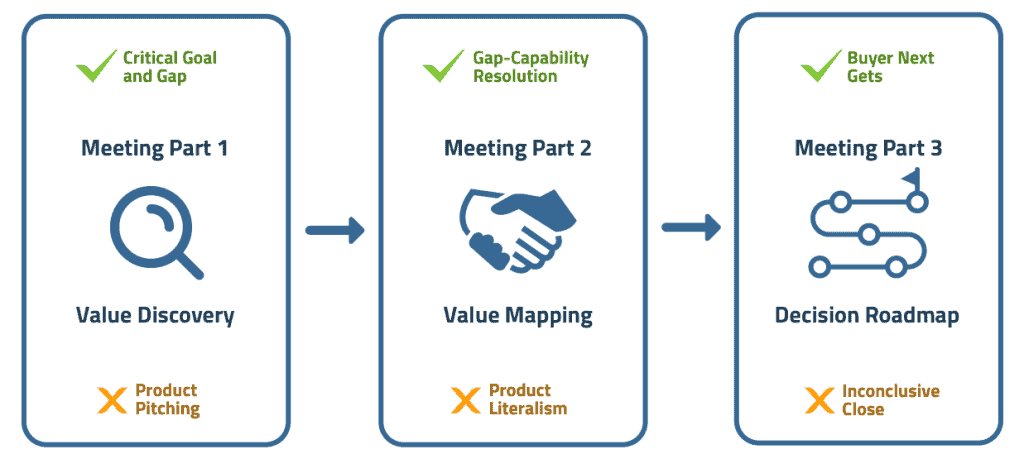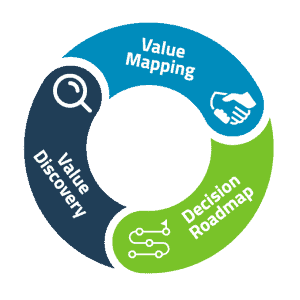The majority of sales meetings miss the mark for both the buyer and seller. A few years back Forrester did research showing that 80% of executives do not find meetings with sales representatives valuable. Recent research from Xant (formerly InsideSales) on more than a quarter million sales deals shows that only 28% of closed deals are predicted accurately 90 days out. This means, on the seller side, sales meetings are not being used to qualify buyers, avoid deal stalls and build velocity into a close.
Most sales meeting dysfunction results from three unforced meeting errors: product pitching, product literalism, and inconclusive meeting closes. The solution is to help sellers proactively manage their meetings in three parts, with each part of the meeting designed to guard against one of these three unforced errors and manage meetings towards higher deal velocity and close rates.

Sales Meeting Blues
Clearly there is sales meeting dysfunction out of the seller’s control. We get prospects who are tire-kicking and casually exploring a variety of products or doing product research for a boss who has no current buying need or is too low-level to have influence or decision authority.
However, most sales meeting dysfunction is caused by three common errors we sellers make in letting things go off track by letting buyers take control of our meeting. These three errors include:
- Product Pitching: Buyers often ask us to quickly share product features or demos. The practical result is that we often “move to product” before really understanding a buyer’s goals or why they took the call. Product discussions that are not mapped to a specific buyer goal or targeted improvement become boring and abstract quickly and lead buyers to tune out.
- Product Literalism: Buyer questions and objections normally suggest a prospect’s buying intent or an interest in a specific use case. Most sellers answer buyer questions or objections literally, offering specific details on product functionality and then saying “did I answer your question?”. The key miss here is an opportunity to pivot the question back to learn more about the buyer’s goals and potential use cases.
- Inconclusive Closes: Sellers often miss the opportunity in sales meetings to effectively qualify a prospect. A very common meeting pattern is to let the the buyer continue to ask product questions or we ourselves continue our product demos right until the allotted time is used up and then end with “Good meeting, thanks for your time, I will email you next week to follow-up?” In contrast, the last part of any sales meeting should be used in real-time, with the buyer right in front of us, to confirm areas of perceived fit, individuals and steps the buying process, timelines and funding options.
Three-Part Meetings, Three Meeting Goals
The easiest way to improve deal velocity and avoid deal stalls is to train your sales team to run meetings in three parts with each part designed to avoid these three common, unforced meeting errors and to secure one of the three key meeting outputs for a high velocity deal.
- Part I: Critical Goal-Gap: The first part of any sales meeting should start with discovery, rediscovery or confirmation of a critical goal. Critical goals typically align to an organizational-level priority, like improving revenue, reducing costs, managing budgets, increasing staff impact or changing user or employee behavior. Critical goals can be found in an organization’s strategic plan, product roadmap or CEO, VP, or leadership team’s priority list. Starting with discovery on the buyer’s critical goals and main gaps to achieving those goals not only builds engagement, as the buyer leans into to tell us how we can help, but it also shows us where to focus our product discussion.
- Part II: Gap-Capabilities Resolution: The middle part of a sales meeting then has to map your company’s capabilities to resolving gaps to a critical goal. Our goal is not to share and answer questions about our product, but to show how our product closes a gap or advances a desired improvement. It is the gap to goal resolution and advancing on a targeted improvement that builds the case to justify any purchase. Mapping can involve describing specific product capabilities and more importantly sharing spoken case studies with evidence that these capabilities have helped other similar companies. In its 2015 study “Selling Tools of the Trade: What are the Must-Haves?” Aberdeen showed that Best-in-Class sales organizations are 69% more proficient at mapping products and services to their prospects’ business challenges.
- Part III: Decision Roadmap: The third part of the meeting should be used by the seller to gauge the buyer’s readiness to take steps to build organizational support to purchase. This starts with confirming if the buyer sees a fit between their goals, gaps-to-goal achievement and our capabilities. If the buyer confirms fit, then the more actions a buyer is willing to take to bring in other decision-makers, to explore funding and timeline options, to build a business payoff, the more qualified the deal. It is these “hard questions” around buyer commits that usually do not receive enough air time, but are the most important in qualifying the deal.
Practicing Three-Part Meetings
Effectively running three-part meetings to improve deal velocity and avoid deal stalls, requires new talk tracks, new questions, and a lot of practice. Here are three ways to help your team build these skills.
- Practice #1: Three-part agenda
- Practice #2: Deal coaching and email review
- Practice #3: Meeting transitions
Practice #1: Three-part Agenda
A best practice in managing three-part meetings is to start with an agenda, co-developed by the buyer, that covers all key meeting sections. Here’s a generic example:
- Time Check: We set an agreed on <time minutes>, does that time still work?
- Agenda: Here were the things I was hoping to cover in our time today:
- Quick overview of us and the challenges we solve
- Understanding of your key goals and priorities
- Explore alignment with our capabilities
- If the fit is right, then identify the right group for a follow up discussion
- Buyer Goal: Does that all sound right? Did you have a top priority for our meeting? Or is there anything specific you wanted to make sure we cover?
Practice #2: Deal coaching and email reviews
A second best practice for building skills for three-part meetings is to integrate follow-up coaching emails into your deal reviews. Along with your sales team, you can review an email to look at specific evidence on goals/gaps, gap resolution, and a decision roadmap.
- Email Review Coaching Questions:
- Did you recap the buyer’s goals and gaps in a specific payoff statement?
- Could you identify a specific target improvement around the goal and payoff?
- Did you avoid a long list of product capabilities in favor of mapping two or three capabilities most relevant to the buyer’s goal, gap, and desired payoff?
- Were you able to identify next steps in the buyer’s decision process, and most importantly identify the right point to involve the economic buyer?
- Were you able to do all of this in a 150-200 word follow-up email, with details on product and success cases either as an attachment or below your signature line?
Practice #3: Meeting transitions
A third best practice for building skills to manage three part meetings is to help sellers with transition language for each of the three key meeting phases.
- Finishing goal-gap discovery: When buyers ask us to share product features or demos before we really understand their goals, we want to commit to our discovery while remaining responsive. The best way to do that is to say something like:
- “There are lots of parts of our product I can share. Can I ask a couple more questions on your goals to focus on the right part of our product and use both of our time well?”
- Transitioning to capability mapping: We can use the transition from discovery to sharing capabilities as an explicit checkpoint that we understand top goals by saying something like:
- “Thanks for taking the time to walk me through your goals and gaps. I understand that your top area of focus is X and next area of focus is Y. So, I am going to focus my product discussion and demo in that order. Did I get those priorities right?
- Avoiding Product Literalism: When you are talking through capabilities and buyers ask product questions, continue to focus on discovery while remaining responsive. A simple technique is to answer the buyer’s question and then say:
- “Now, I’d welcome learning about why you asked that question? How does that question relate to your buying goals and priorities?”
- Transitioning to decision roadmap: Many meetings run out of time and have an inconclusive end with no commitment to concrete next steps to explore a partnership. We can guard against this by starting the transition to the decision roadmap with 10 to 15 minutes left. For example:
- “I want to be aware of our time. We have another 10 or 15 minutes today. We have talked about your goals and our capabilities, can we now transition to explore areas you think we might be able to partner and how we can continue the conversation?”
Assessing Your Meeting Management: A Simple Self-Diagnostic
Here are a few questions you can ask yourself as you think about improving your team’s meeting management to avoid unforced deal stalls:
- Have you asked your team to start running meetings in three distinct parts focused on discovery, capabilities, and the decision process?
- Have you encouraged your team to develop a meeting agenda that sets up three meeting parts?
- Has your team developed and practiced language to manage meeting transitions?
- Have you developed coaching strategies to review three-part meetings?
- Are you doing joint calls and call coaching? Does your coaching include follow up email reviews?
Committing to the three-part meeting technique and practicing with your team will pay dividends far beyond any other sales practice. Most importantly, it will help avoid all the major causes of deal stalls.
